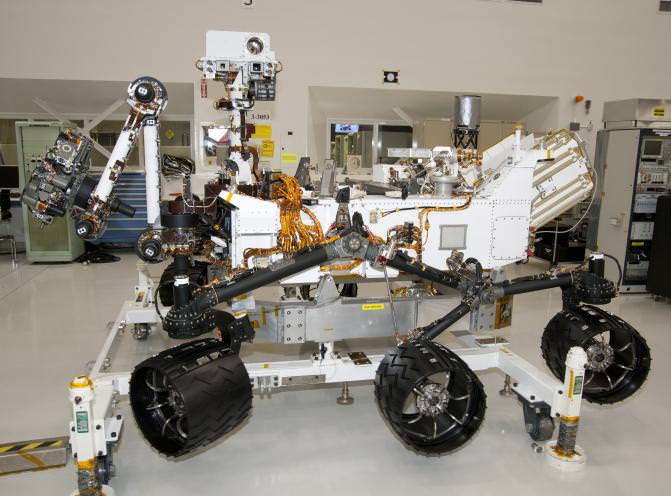[/caption]
NASA's massive
'Curiosity' rover
is almost ready to begin the first leg of its long trek to the
surface of the Red Planet
. Engineers at
NASA's
Jet Propulsion Laboratory in California are nearly finished with assembling and testing all the components of the
Mars
Science Laboratory (MSL) mission (see photos above and below).
The MSL team plans to ship
Curiosity
as well as the cruise stage, descent stage and back shell to the
Kennedy Space Center
(KSC) in May and June. After arriving at KSC, all the pieces will be integrated together and tested during final assembly in a clean room. The
rover
will then be installed inside a 5 meter diameter nose cone, shipped the short distance to Cape Canaveral and then bolted atop an
Atlas V
rocket
(photo below).
[caption id="attachment_84704" align="aligncenter" width="580" caption="Top of Mars Rover Curiosity's Remote Sensing Mast. The remote sensing mast on NASA Mars rover Curiosity holds two science instruments for studying the rover's surroundings and two stereo navigation cameras for use in driving the rover and planning rover activities. Credit: NASA/JPL-Caltech"]
[/caption]
The launch window for
Curiosity
extends from Nov. 25 to Dec. 18, 2011. The first stage of the
powerful
Atlas V
rocket will be augmented with four solid rocket boosters. The Atlas V has previously launched two planetary missions; the Mars Reconnaissance Orbiter (MRO) and the New Horizons mission to Pluto.
Take a long gander at the 3 meter long
rover
because its appearance is now very much how it will look while it's roving along
intriguing martian landscapes
for at least two earth years after landing in August 2012.
[caption id="attachment_84705" align="aligncenter" width="580" caption="NASA Mars Rover Curiosity at JPL, View from Front Left Corner. Support equipment is holding the Mars rover Curiosity slightly off the floor. When the wheels are on the ground, the top of the rover's mast is about 2.2 meters (7 feet) above ground level. Credit: NASA/JPL-Caltech"]
[/caption]
The mini-Cooper sized
Curiosity rover
is equipped with 10
science instruments
to
investigate Martian soil
and rock samples in far greater detail than ever before. Curiosity's science payload weighs ten times more than any prior
Mars rover
mission.
The goal is to search for clues to environmental conditions favorable for microbial life and for preserving evidence about whether
Martian life
ever existed in the past or today.
NASA
is scrutinizing a list of four potential landing sites for the best chance of finding a
habitable zone
.
[caption id="attachment_84706" align="aligncenter" width="580" caption="Arm and Mast of Curiosity Mars Rover. Curiosity's arm and remote sensing mast carry science instruments and other tools for the mission. This image, taken April 4, 2011, inside the Spacecraft Assembly Facility at JPL shows the arm on the left and the mast just right of center. Credit: NASA/JPL-Caltech"]
[/caption]
[caption id="attachment_84708" align="aligncenter" width="386" caption="Atlas V rocket at pad 41 at Cape Canaveral Air Force Station. An Atlas V rocket similar to this one with a 5 meter diameter nose cone – but with 4 solid rocket boosters added - will launch Curiosity to Mars in late 2011. Credit: Ken Kremer"]
[/caption]
[caption id="attachment_84709" align="aligncenter" width="580" caption="Atlas V launch vehicle will blast Curiosity to Mars "]
[/caption]
 Universe Today
Universe Today
